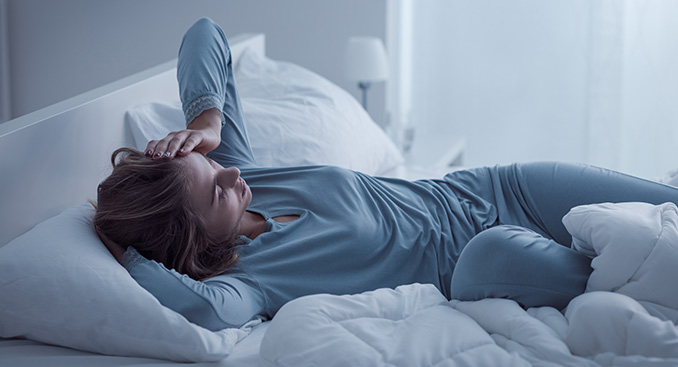The Risks and Treatment of Common Sleep Disorders

Sleep is more than a luxury; it's a necessity. Adults should get at least seven hours of sleep per night for optimum health, however, the Centers for Disease Control and Prevention estimate about 39 percent of adults aren't sleeping enough.
Sleep disorders can have a major impact on sleep quantity and quality, says Shayla Pullen, MD with TriHealth Physician Partners Sleep Medicine. She described three of the most common sleep disorders, how to identify their symptoms and how to treat them.
Sleep Apnea
Over 30 million Americans have sleep apnea, according to the National Sleep Foundation. This disorder is associated with nonrestorative sleep, difficulty falling and maintaining sleep and snoring. These symptoms stem from a pause of 10 seconds or more in the affected person's breathing. The most common form of sleep apnea is obstructive sleep apnea, which occurs when there is a partial or complete collapse of the back of the throat during sleep.
"When the airway collapses, poorly oxygenated blood goes to the brain, which responds by sending a signal to the heart to beat stronger, harder and faster," Dr. Pullen explains. "That racing of the heart increases the blood pressure each time an apneic event occurs."
Because of the strain sleep apnea puts on the heart, it can have serious complications, including atrial fibrillation, heart attack, stroke and congestive heart failure. Because of this, it's crucial to see a doctor if you are concerned about your nighttime sleep symptoms.
The most common sleep apnea treatment is a CPAP machine, says Dr. Pullen. It is a breathing mask worn by sleep apnea sufferers while they sleep. It provides a gentle air pressure which keeps airways open during the night. When used correctly it is 90 to 95 percent effective in treating sleep apnea. Other treatments include an oral appliance known as a mandibular advancement device, surgery or an implant which helps improve muscle tone in key tongue muscles.
Risk factors for sleep apnea include obesity, being over age 65, being post-menopausal, and genetics, which affect the way your airway is structured. Men are more likely to have sleep apnea than women.
Insomnia
Insomnia involves having difficulty falling asleep, poor sleep maintenance, waking up frequently throughout the night or difficulty falling back asleep: "If it takes longer than 30 minutes to fall asleep, you may have insomnia," says Dr. Pullen.
Before diagnosing insomnia, however, Dr. Pullen says she looks for other reasons why a patient may have difficulty falling or staying asleep.
"It's a diagnosis of exclusion," she explains. "Sometimes, the person may actually have sleep apnea and not know it."
Diagnosis of many sleep disorders will include a sleep study which monitors how the patient's body reacts to sleep. Once other factors have been considered and there are no other contributing factors, a sleep specialist can assign the diagnosis of insomnia.
Treatment can include cognitive behavioral therapy, eliminating external stimuli (e.g. installing blackout curtains, playing white noise) and possibly adding a sleep aid for a short period of time.
Restless legs syndrome
Restless legs syndrome (RLS) involves an uncomfortable feeling in the legs at the end of the day, in the evening, when trying to go to sleep or at night. The feeling persists until you are forced to get up and move.
"Many people have RLS. We don’t know what causes most cases, however low ferritin associated with iron deficiency is the only known cause," Dr. Pullen says. "In patients with low ferritin, an iron replacement can resolve RLS. For everyone else, however, we will often treat them with medications such as Mirapex and Requip, a dopamine agonist.”
For those who don't fall under these sleep disorder categories but still occasionally struggle with going to or staying asleep, Dr. Pullen suggests implementing a sleep routine with a set schedule you don't deviate from each evening and each morning so your body can predict when it's time to sleep and wake.
"Start your bedtime routine one to two hours before your desired bedtime. Don't exercise, dim the lights, avoid eating a large meal or drinking caffeine and avoid bright lights such as those found in electronics as these will affect neurotransmitters, stimulating the brain," Dr. Pullen explains.
"Anchor wake time each morning so you aren't shifting sleep cycles," Dr. Pullen says. "College students often have delayed sleep cycles and which means they end up having a hard time falling asleep and waking up."
She also advises avoiding doing anything in bed beyond sleep and sex: "You should see your bed and immediately feel sleepy," Pullen said.
If, however, you lay in bed awake for 20 minutes and can't fall asleep, get up and do something then return to bed, Dr. Pullen recommends. This will help quiet your mind and reset your inner clock, so you feel less pressure to fall asleep.
To learn more about sleep disorders or to set up an appointment, call 513 569 5400 or find a sleep provider near you.